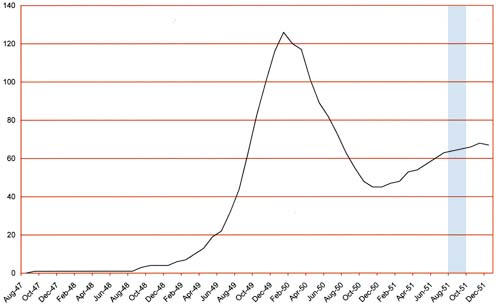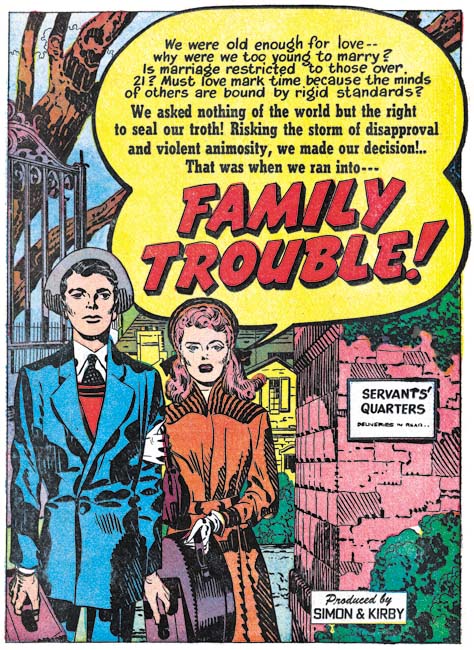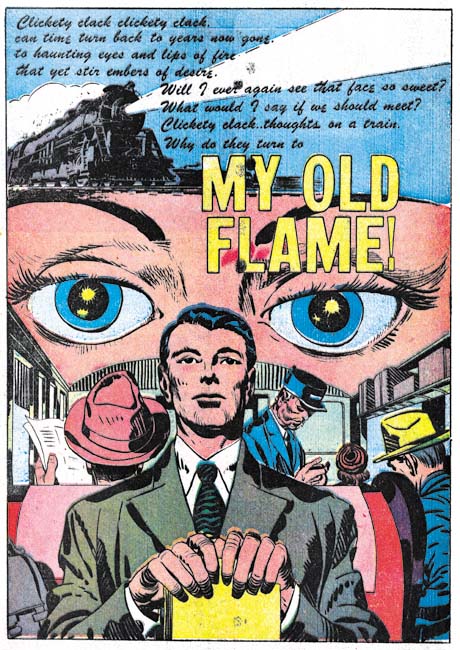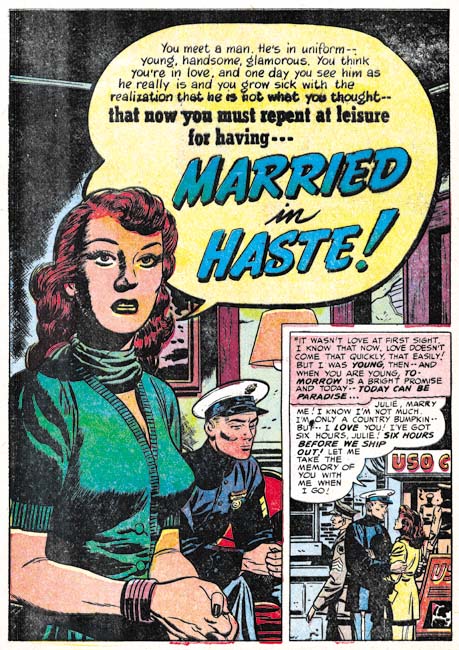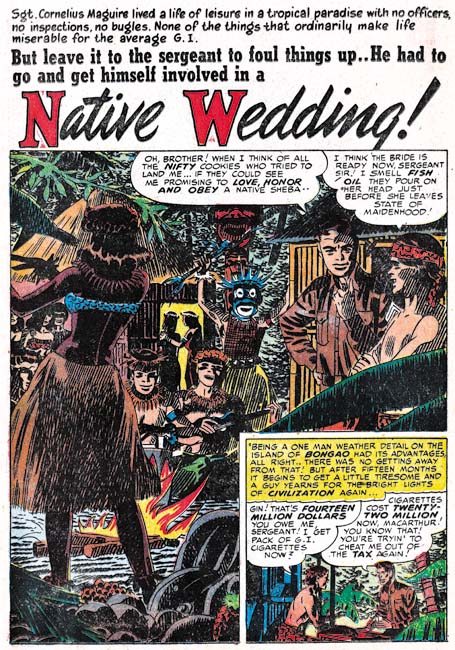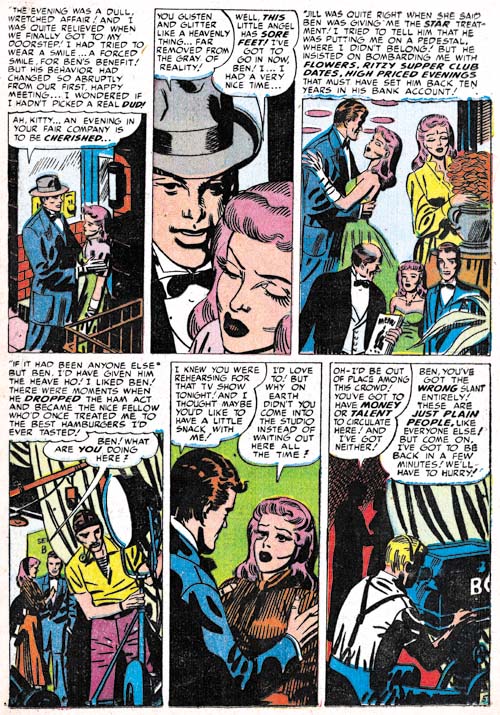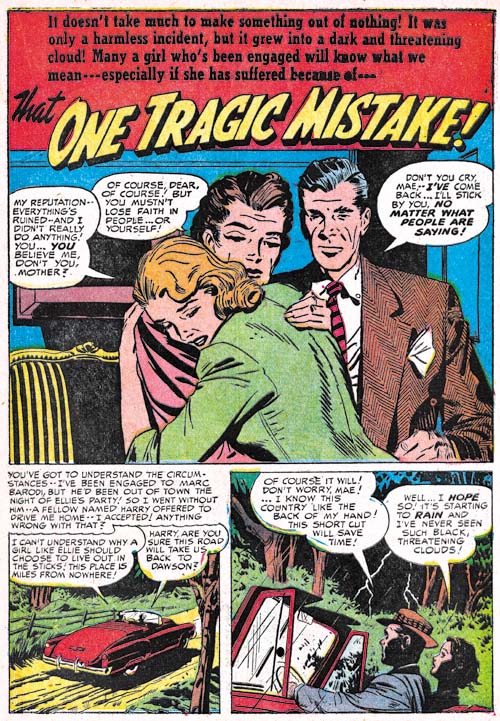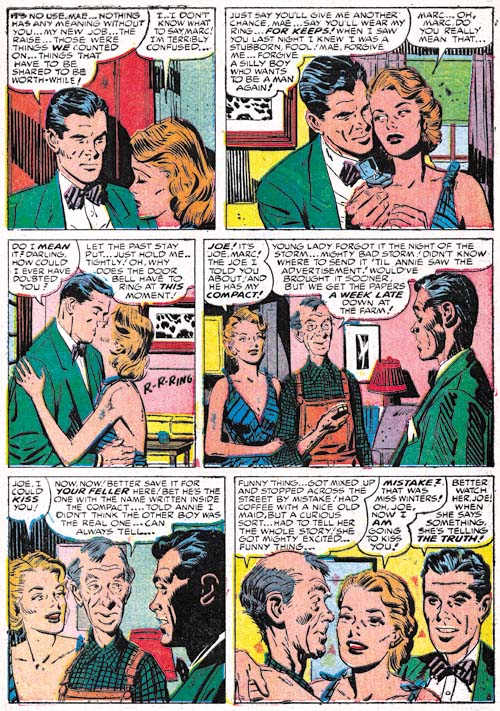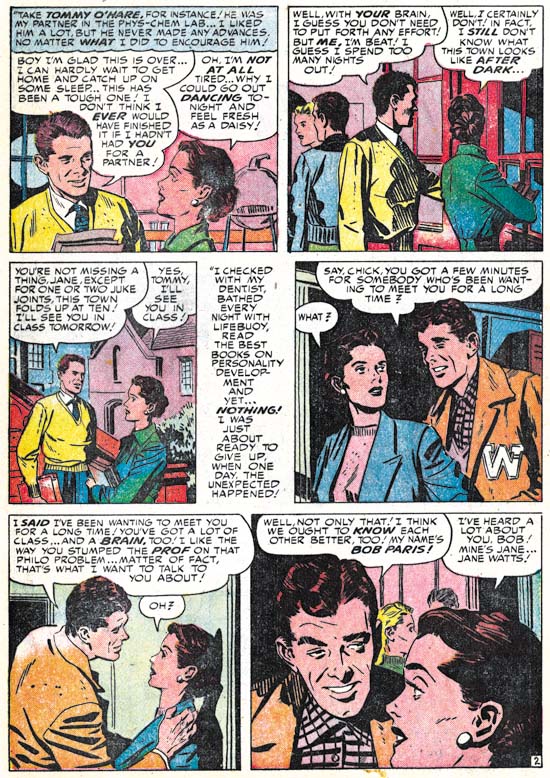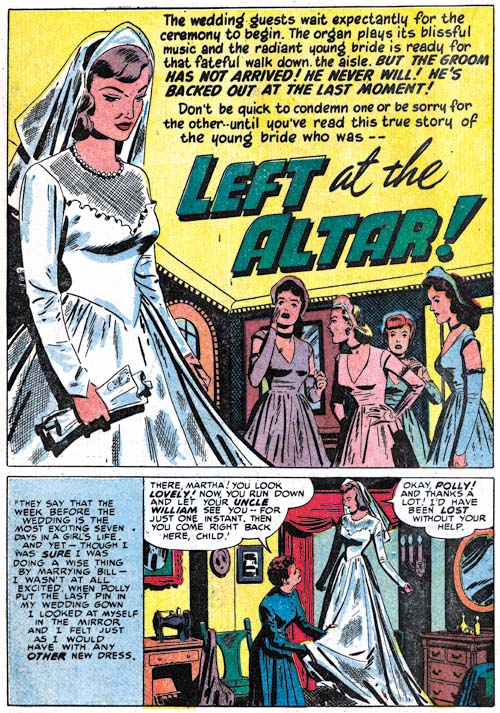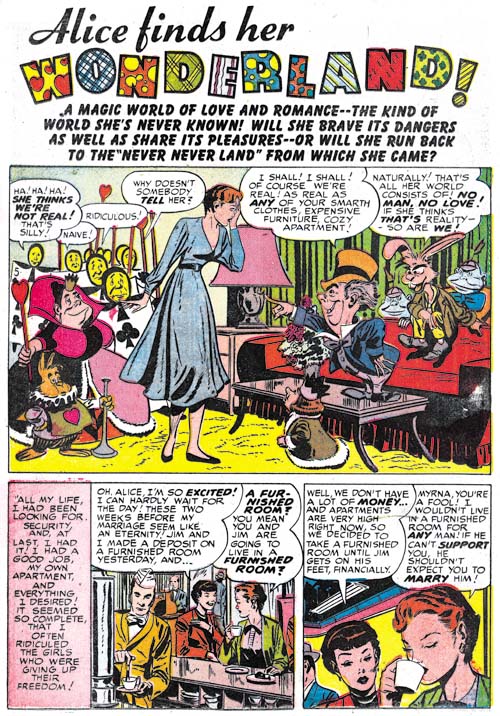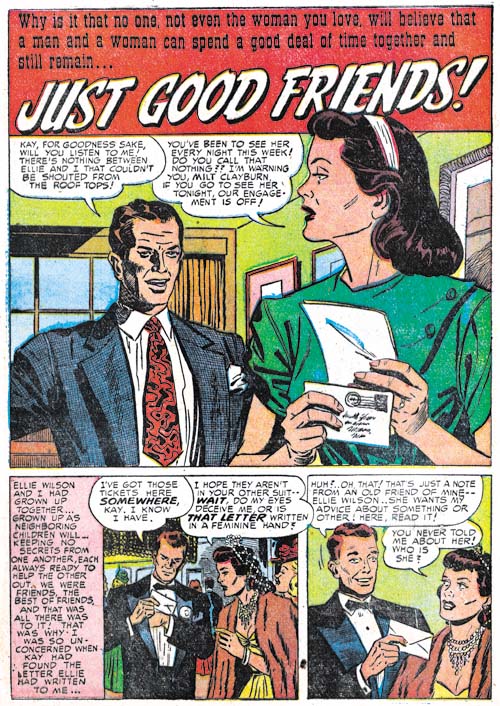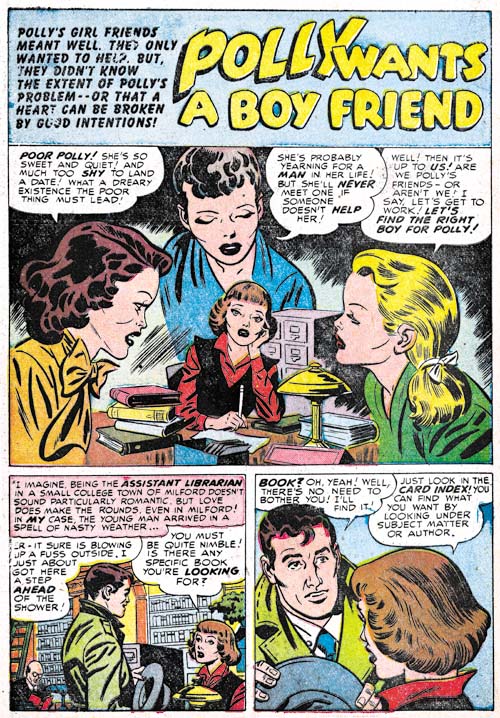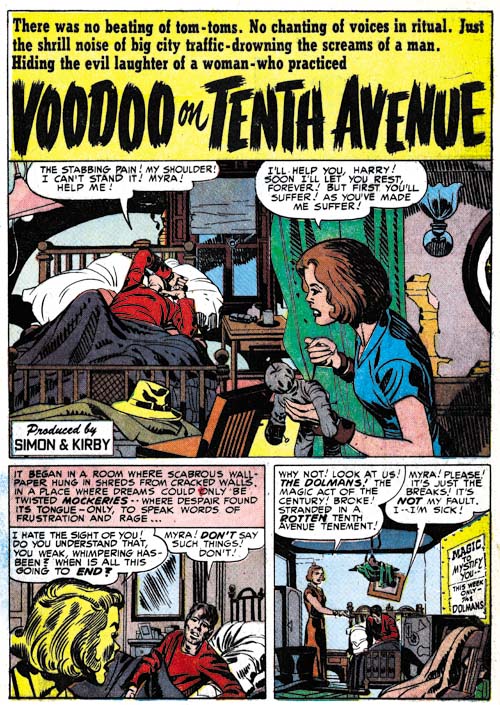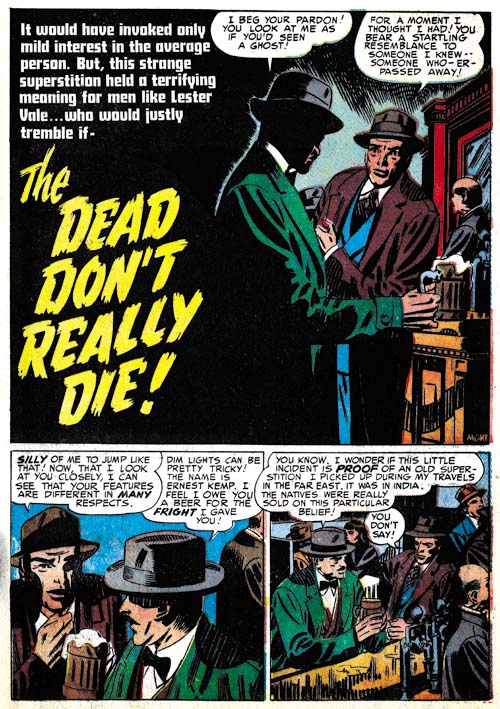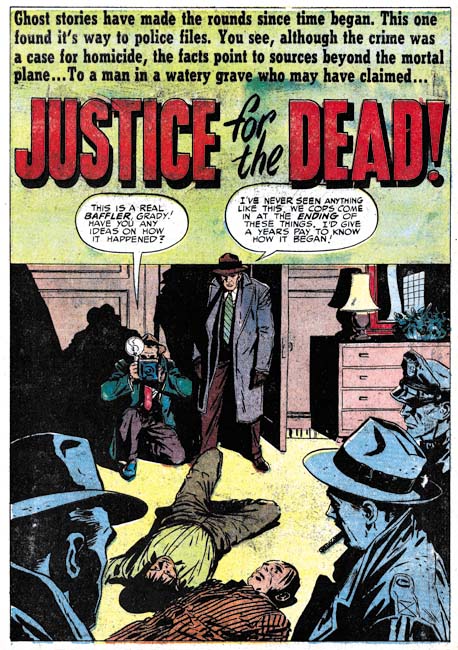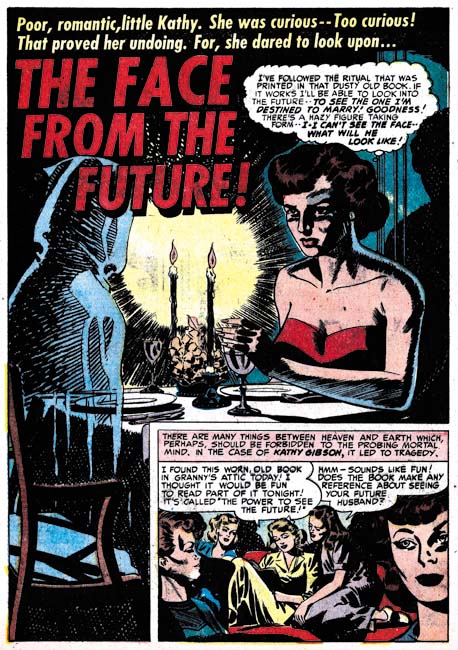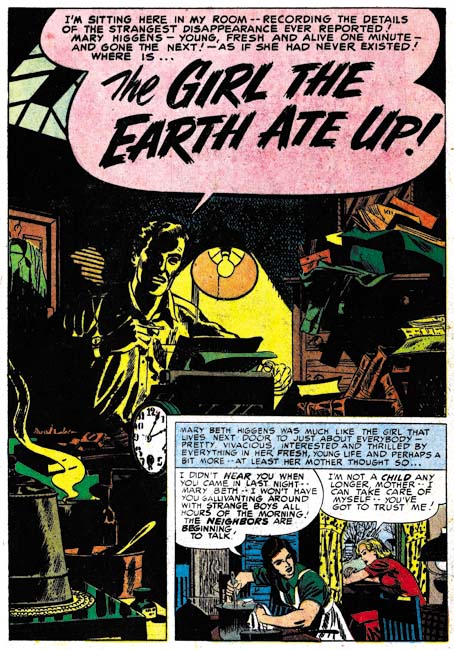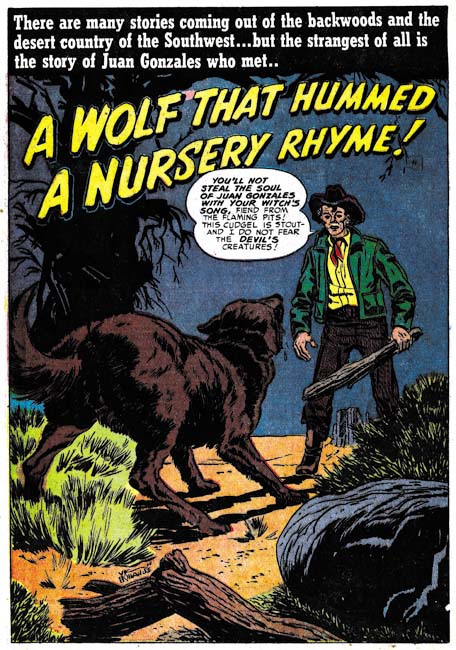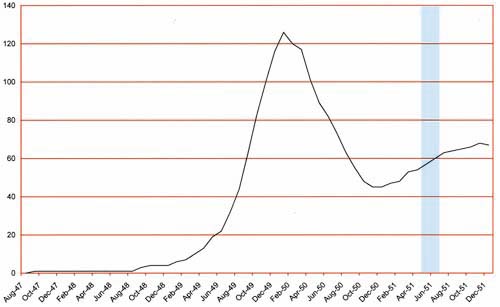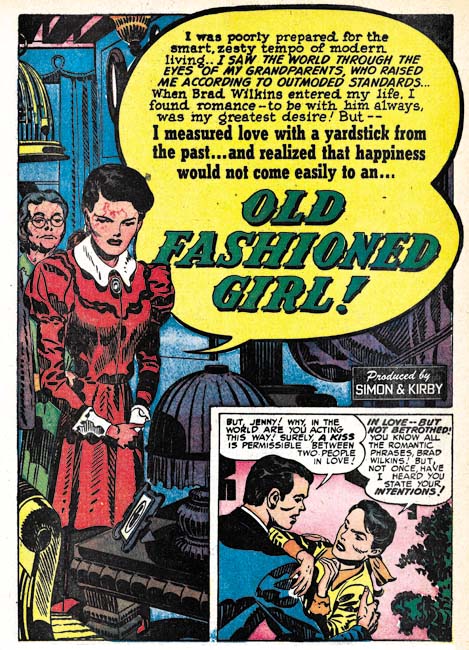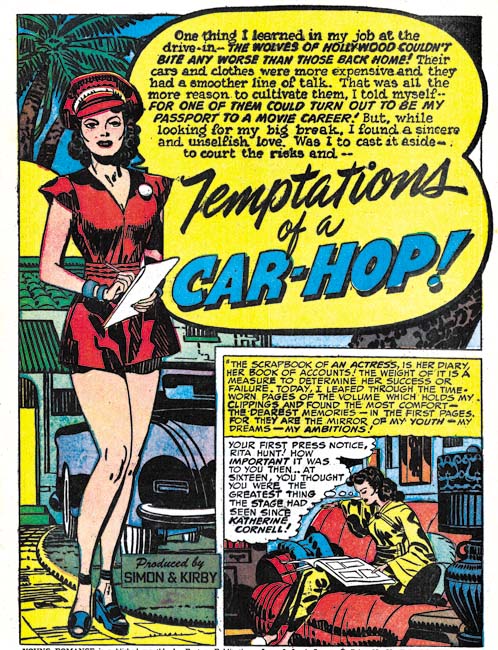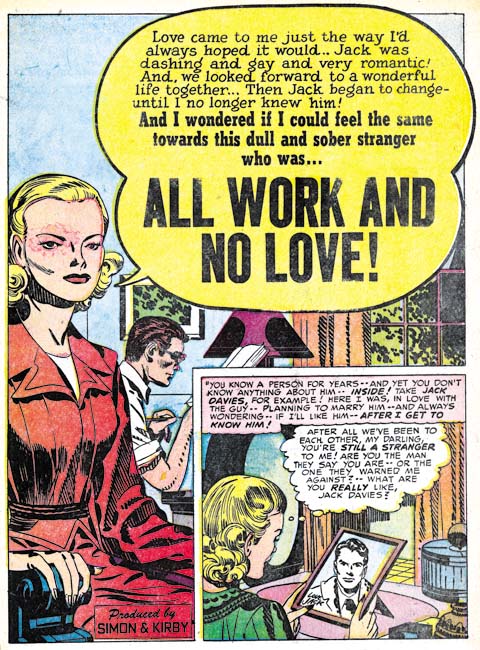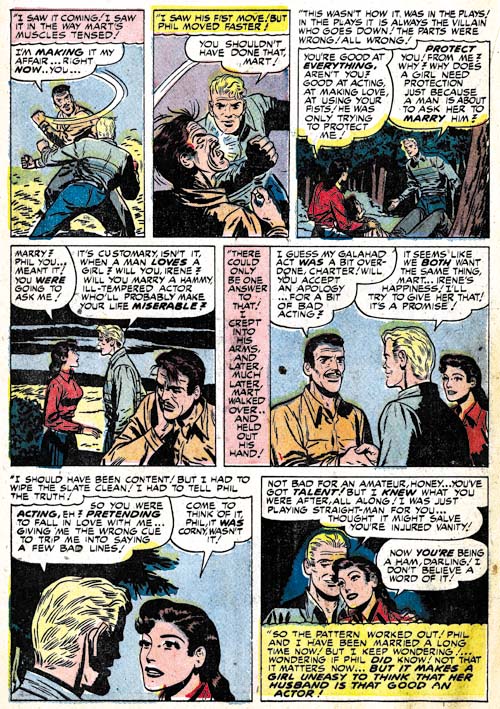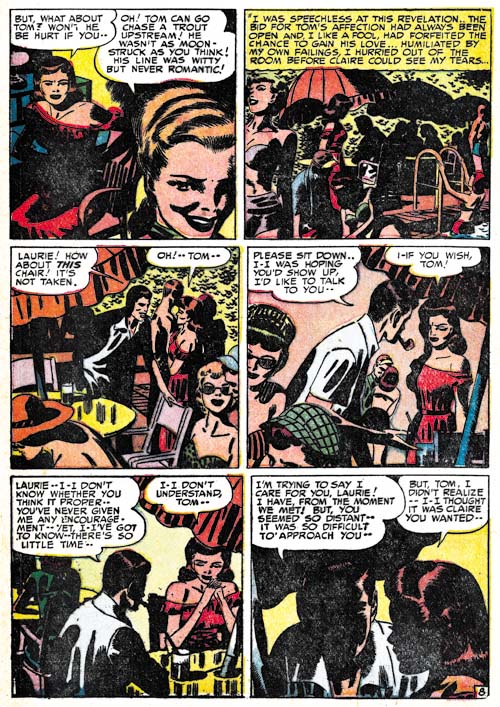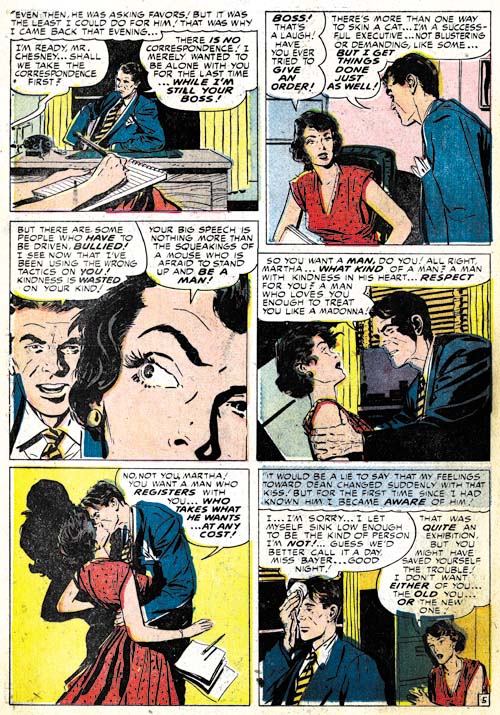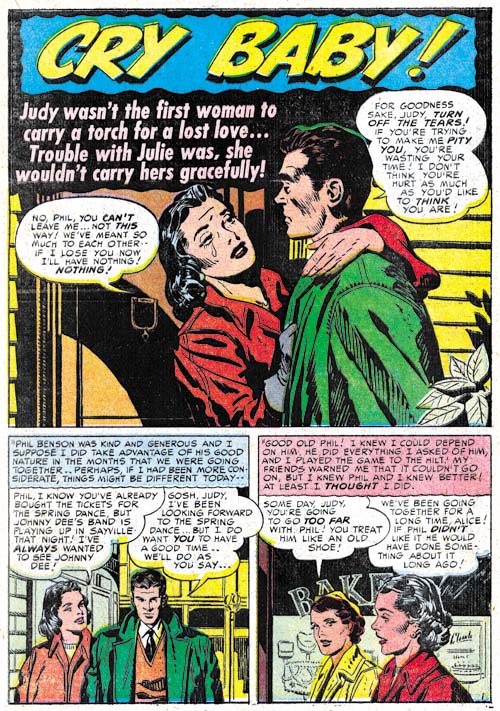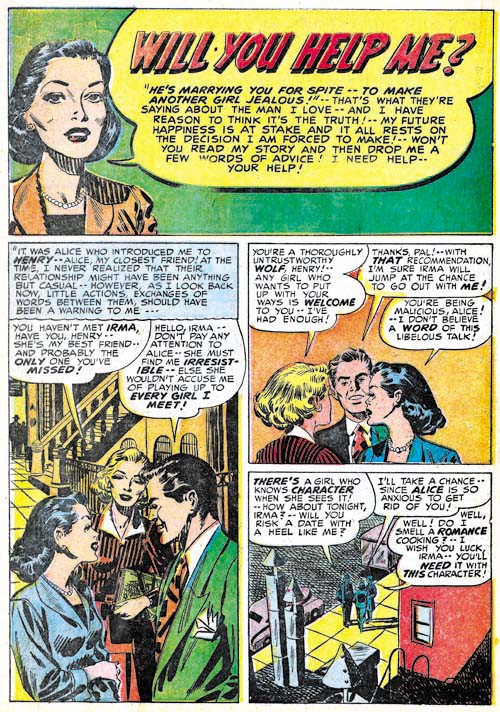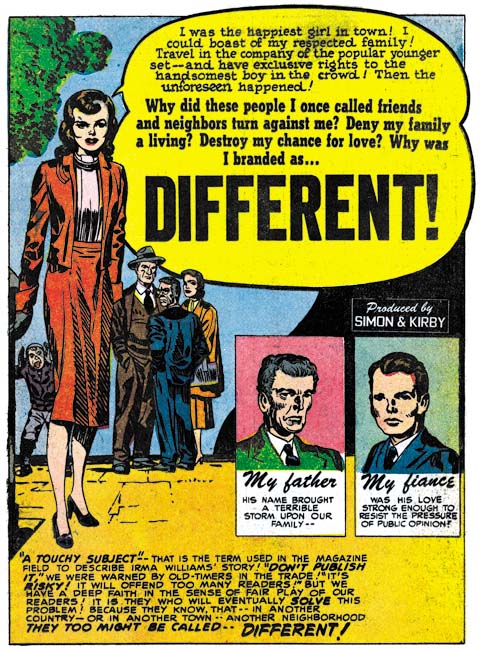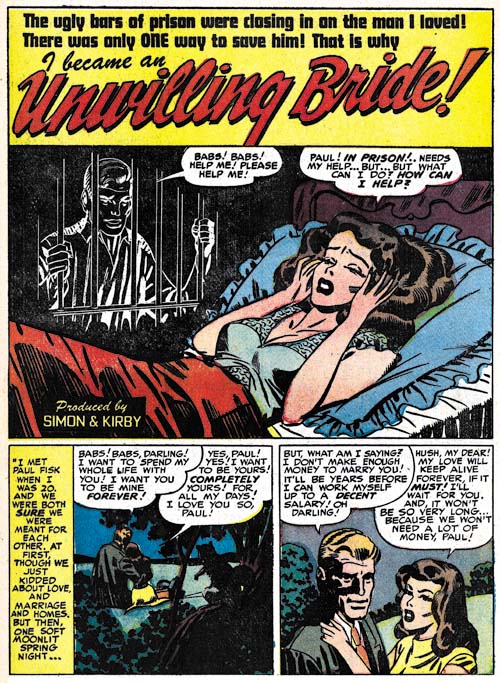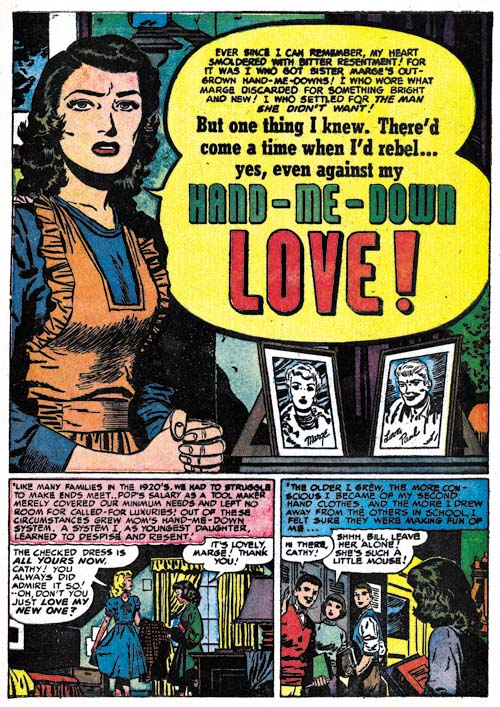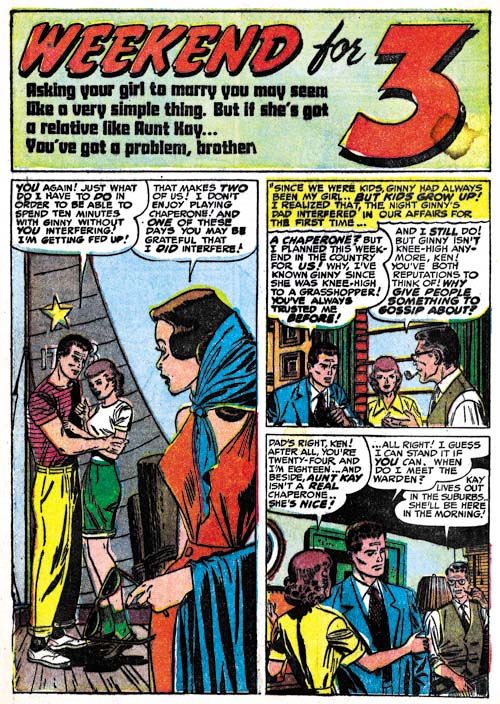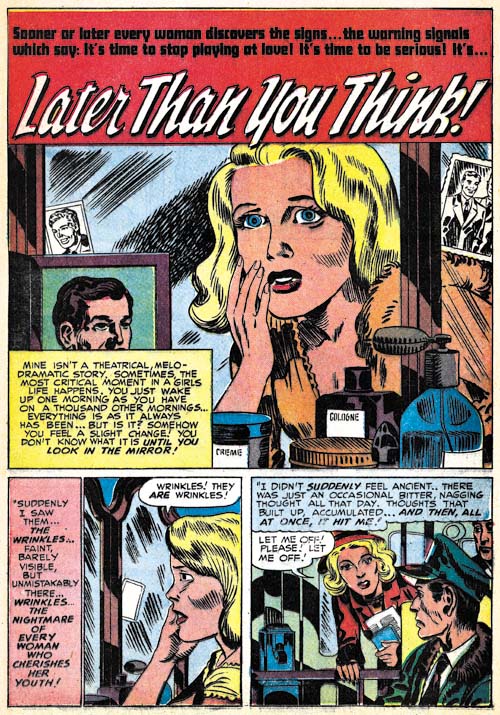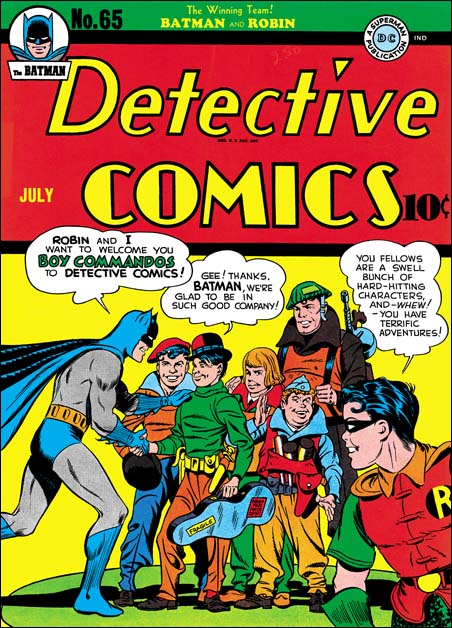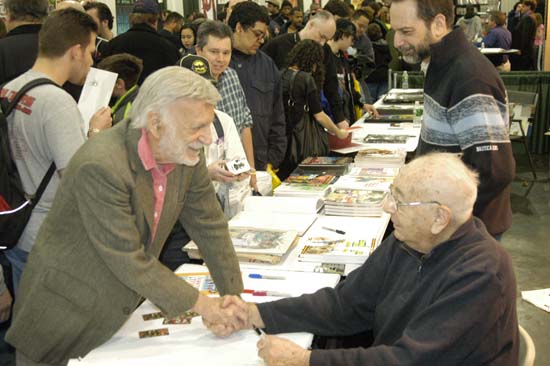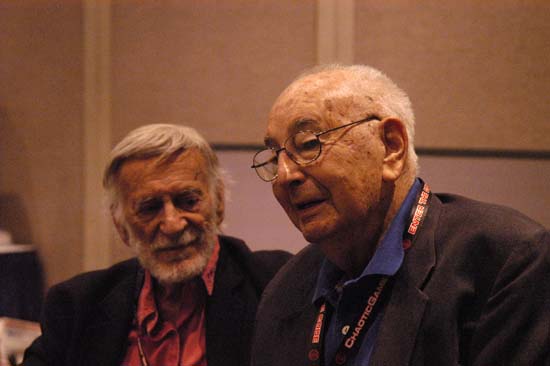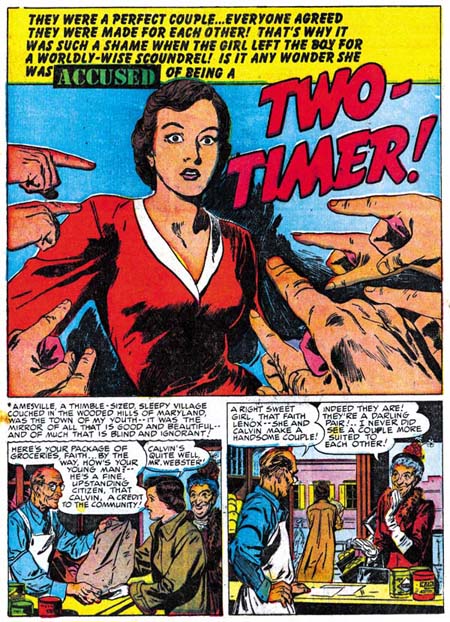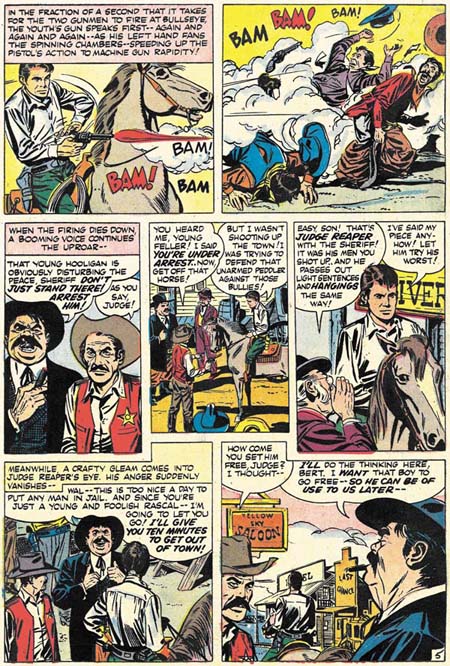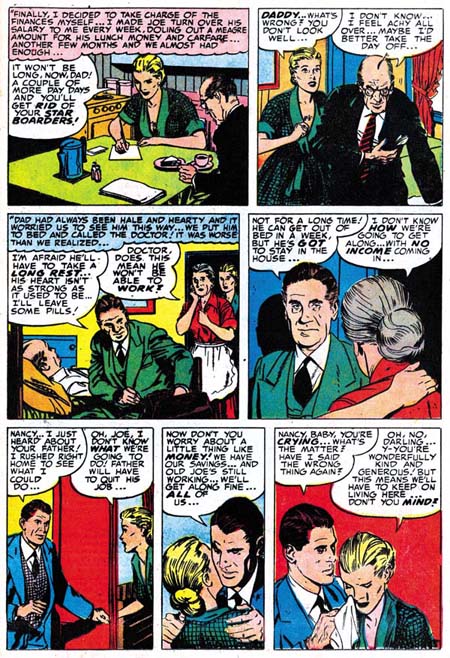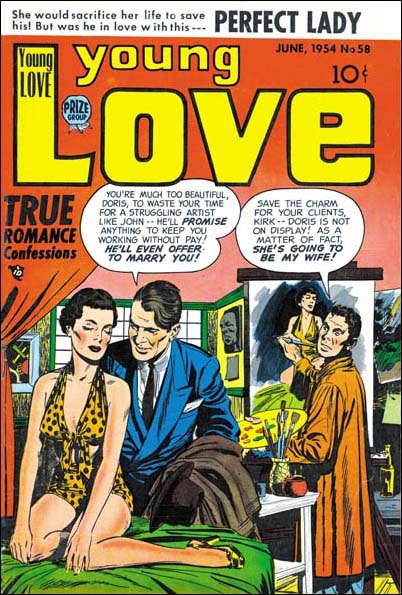(November 1951 – January 1952: Young Romance #39 – #41, Young Love #27 – #29)

Number of Romance Titles 1947 – 1953 (the period covered in this chapter is shaded in blue)
There has not been much change in what the Simon and Kirby studio was producing which were two monthly romance titles and one bimonthly horror all for Prize Comics. I believe all three titles were doing well but I will leave off explaining what is behind my belief until Chapter 20 of The Art of Romance and Chapter 3 of The Little Shop of Horrors.
Mort Meskin was really going strong during the period covered in this chapter. Joe Simon described in “The Comic Book Makers” the difficulties Mort had when he first came to work for Simon and Kirby. I do not know if someone was still marking Meskin’s pages with scribbles to get Mort over his fear of the blank page or if Mort had worked past his problems. Either way Mort did 82 romance pages; much more then any other studio artists. The second place was once again Bill Draut. Bill was not famous for his speed and there is no particular reason to believe he was faster then the average comic book artist but even so he managed to do 59 pages during this period. Jack Kirby remained in third place but with 32 pages the gap between him and Draut had widened. Jack did all the lead stories for Young Romance but that was all he did; he did draw any backup stories for Young Romance and he did nothing at all for Young Love. Jack only did a single page more then John Prentice’s 31 pages. The remaining work was done by 2 other artists discussed below (16 pages by one and 2 by the other). Marvin Stein, Vic Donahue and Ross Andru were artists present in last chapter but they do not show up in the issues covered in this post.
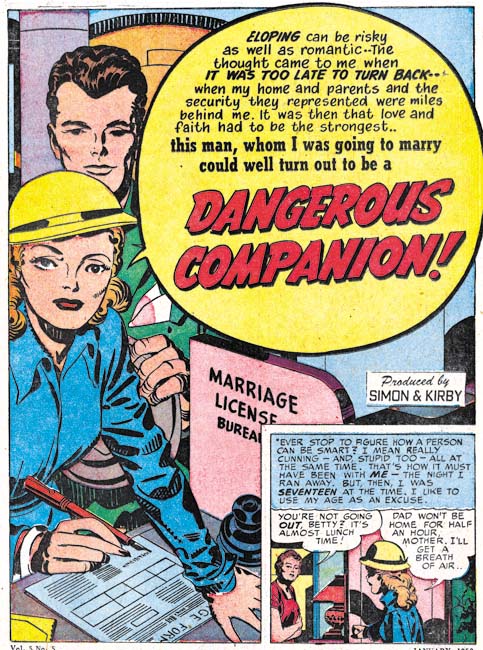
Young Romance #41 (January 1952) “Dangerous Companion”, art by Jack Kirby
I have a particular fondness for Kirby’s romance splashes. They may not rate high with Kirby fans today but they should. Some are his finest creations and work well as stand alone art. Unfortunately there is only one outstanding splash during this period, the one for “Dangerous Companions”. There is nothing special about the scene Jack presents. It is little more then a couple getting a marriage license. When put into words like that it sounds quite boring. I can explain some of the reasons I find this work so engaging. The high viewing angle not only lets the reader see all that is going on but makes him feel his is part of the story, like he is standing behind the counter. Each part of the composition plays its part both visually and for telling the story. The lady is quite attractive and, at least as I am concern, is proof that Kirby did draw beautiful women. With her raised eyebrow she pauses before she signs the form and seems to want to ask us, a stranger, if she is doing the right thing. All these are good and valid reasons why this splash works so well but in the end they do not fully explain it. As so often with Kirby, or any great artist, there is some magical quality that cannot be put into words but cannot be denied.
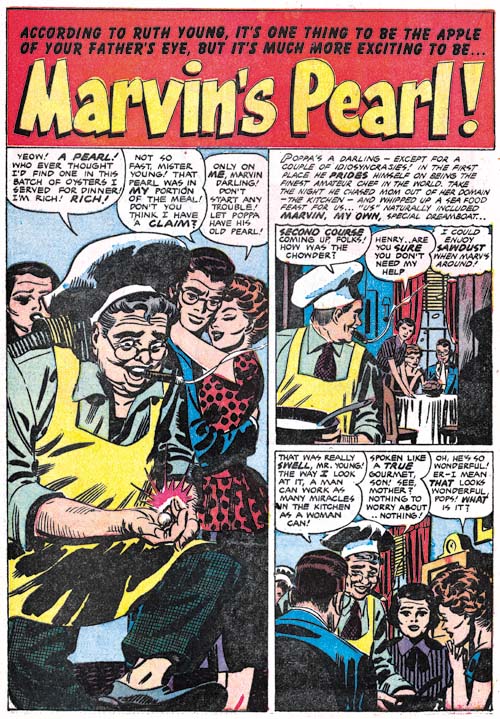
Young Romance #39 (November 1951) “Marvin’s Pearl”, art by Mort Meskin
Mort Meskin drew a lot of great art for Simon and Kirby but I have a special fondness for “Marvin’s Pearl”. Much of the credit has to go to the unknown writer. It is a light hearted tale of a pearl found in a meal and the effect it has on the people involved. However it took the Meskin’s skill to transform the script into such a delightful graphic story. I particularly like Mort’s interpretation of Marvin. Is it possible to view the splash with Marvin literally dancing with joy without raising a smile? Frankly I cannot imagine any other artist doing a better job on this story then Meskin, not even Jack Kirby.
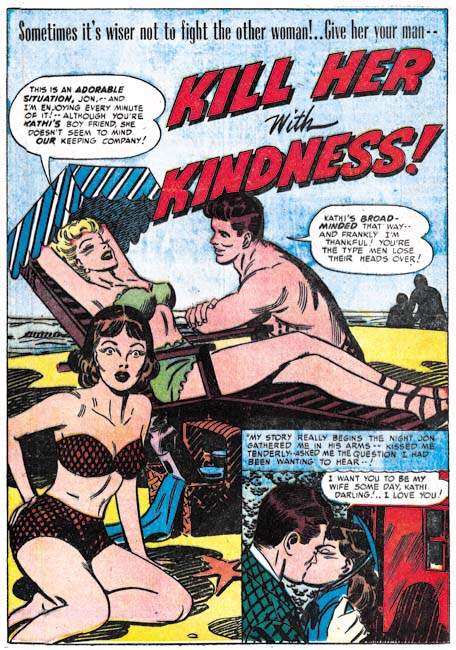
Young Romance #41 (January 1952) “Kill Her with Kindness”, art by Mort Meskin
I often wonder if the teenage female readers of the Young Romance really appreciated such things as the splash for “Kill Her with Kindness”. They might not have enjoyed a scene of scantily clad women but I am certain Mort Meskin liked drawing it. Why else would Mort, who normally used half page splashes, devote an entire page to this beach scene? Even if the size of the splash was dictated by the script writer, Meskin certainly seems to have taken to it enthusiastically.
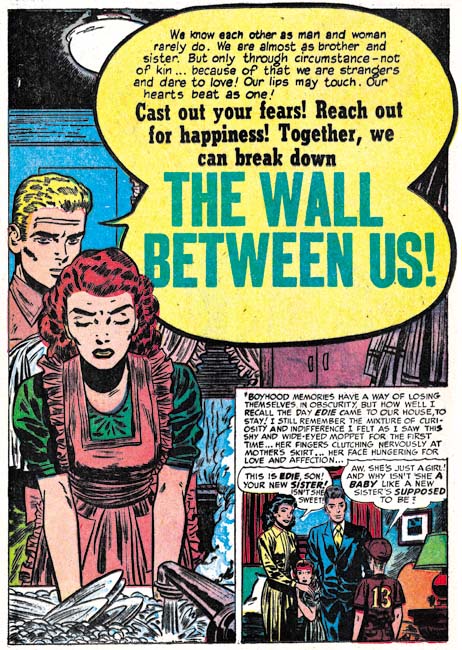
Young Romance #39 (November 1951) “The Wall between Us”, art by Bill Draut
Bill Draut does a confessional splash for “The Wall between Us”. Usually confessional splashes are reserved for the lead story but this is a backup story. There always is the possibility that it was originally meant to be the lead story but got switched after the art was completed. However Kirby is generally the lead story artist for Young Romance and this issue is no exception. I think Draut did a good job on the art work but there seems to be a disconnect between the image and text in the word balloon. Usually in a confessional splash they work very well together and those done by Bill are no exception. But what does washing dishes have to do with the “wall between” the couple? I wonder if the balloon text was a late, and not very successful, alteration?

Young Love #29 (January 1952) “Dumb Blonde”, art by John Prentice
John Prentice’s art is usually easy to spot. Most Simon and Kirby artists were influenced by Milton Caniff but Alex Raymond had the greatest impact on Prentice. John’s women have a more sophisticated beauty and his men a rugged sort of look and small eyes. Like most studio artist, John did his own inking which he did with a very assured hand. I have previously discussed his cloth folds are long and sweeping, and have different shapes they used by Joe or Jack. John’s brush work for hair was also distinct as can be seen in the above splash.

Young Love #29 (January 1952) “Dumb Blonde” page 8, art by Jack Kirby?
The first page of “Dumb Blonde” is typical John Prentice pencils and inks. However the rest of the story is not. Some pages look like Prentice’s inking but the brushwork seems more rushed. Other pages still look like John’s pencils but inked by another. The different look is particularly apparent on page 8 shown above. Compare the way the hair is inked on the last page with what Prentice did on the first. Further the women do not have sophisticated beauty nor the men the rugged looks typical for Prentice. But take a careful look at the man in panels 3 and 5, he looks like he was done by Jack Kirby. Yet the woman does not look like she was drawn by Jack in any of the panels. So what is going on here? The first explanation that comes to mind is that Prentice was working from Kirby layouts. However the story is graphically told in a manner so characteristic of Prentice and not in a Kirby manner at all that I think this explanation can be safely discounted.
The solution I offer is that in the last page of the story Kirby was inking over Prentice’s pencils. Some artists who ink there own work do rough pencils and do the detail work when inking. I have never seen any uninked pencils by Prentice so I cannot say if that was his working procedure. If it was then any artist inking such rough pencils would likely to impart much of their own drawing style to the finished inking; hence the Kirby look of the man in the two panels of the last page. Kirby inking another artist would be quite extraordinary. I believe that the Jack Kirby Checklist includes only three cases that were supposed to be Kirby inking another artist. When I was able to track down copies of these so called Kirby inking I was always disappointed; all of them were clearly not inked by Jack. If parts of “Dumb Blonde” were inked by Jack it would be the only case of Kirby inking another artist that I have found.
I am not sure that Kirby and Prentice were the only inkers involved either. I suspect “Dumb Blonde” was a rush job that had to meet some deadline. As such it probably got the inking treatment normally reserved for Kirby’s pencils where many of the studio artist pitched in to ink the work including Jack himself. Jack was a fantastic artist but he was a really poor ghost artist. He had trouble suppressing his own style and imitating another artist’s mannerisms. Years later Jack would try to imitate other artists in some index pages for Harvey romances. In fact one of the imitate artist was Prentice and Jack was no more successful then (Kirby Imitating John Prentice and Kirby Imitating John Prentice Again).
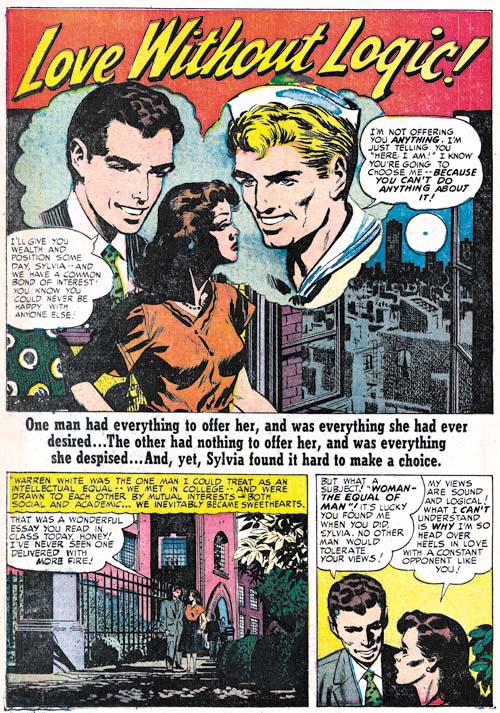
Young Love #28 (December 1951) “Love without Logic”, art by George Roussos
George Roussos started appearing in the romance titles in November. His appearance is not surprising but what is unusual is that it took so long for him to show up. Roussos had been appearing in Black Magic starting in February. Perhaps Joe and Jack thought that while George’s art was very suitable for horror stories it might not work so well for romance. In fact while Roussos was not particularly bad at romance art, he was not particular good at it either. Most of the romance work George did during the period covered in this chapter was for short pieces 1 to 4 pages long. He did do one regular length story called “Love without Logic”. Roussos obviously put some effort into as can be seen by all the fine crosshatching in the cityscape found in the splash. George was a frequent inker of Mort Meskin at DC during the war so it is not surprising to see Meskin’s influence on the art that Roussos did for Simon and Kirby. Not so much in the inking, although both artists had a penchant for including crosshatching done with a pen. It is the drawing that shows the influence but never to the extent that would make it difficult to distinguish the two artists. Meskin was clearly the master and Roussos the follower.

Young Love #28 (December 1951) “Love without Logic” page 2, art by George Roussos and Jack Kirby
The second page of the story is a particularly well executed moody piece full of nighttime shadows. The Meskin influence is well indicated by the woman in panel 5. As good as the piece is look at that first panel. See how the woman raises her eyebrow and her arches her body toward the man. We cannot see his face but his whole body language speaks his desire. But look at his hand. If you have not guessed it already this was the work of Jack Kirby. Compare the trunk of the fallen tree in the foreground with the tree in the last panel. There is no question, that fallen tree was inked by Jack. Further all the foliage is inked in a quick, robust but assured manner very different from the rest of the page. While it is not that unusual to find Kirby stepping in as an art editor and fixing some part of a story it is surprising that he worked on the entire panel. Perhaps Jack was unsatisfied with the entire panel and redid it all but I would like to offer another explanation. Perhaps Jack was using the first panel to instruct George how he wanted the rest of the page to be done. If so wouldn’t you have liked to be a fly on the wall to listen to that discussion? Actually the entire story could be based on Kirby layouts; I see nothing in the story to prove that but nothing to discount it either.
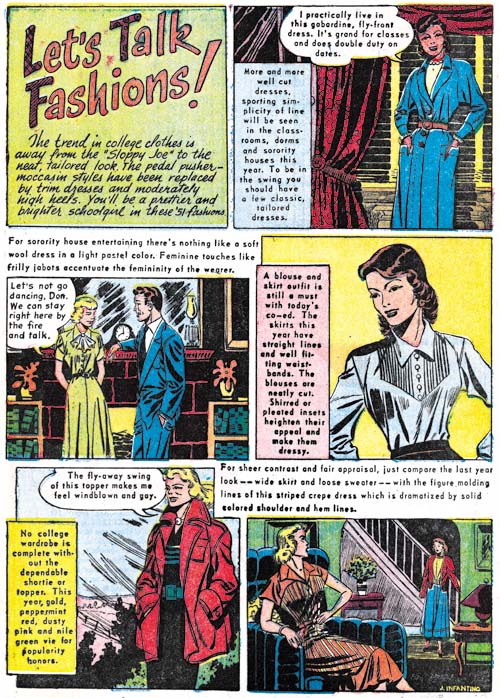
Young Romance #39 (November 1951) “Let’s Talk Fashion”, art by Jim Infantino
This chapter of The Art of Romance is one of the few that I have been able to confidently identify all the artists who provided word during this period. Actually that is now true of the last chapter as well but when I wrote that post there was a single one page feature that I failed to identify then. However I had forgotten about an artist who contributed very little to Simon and Kirby productions and not much more to other comics either, Jim Infantino. Besides the single piece form the period covered by the chapter 15 I can add two other single page features by Jim with only one of them signed. Perhaps more will be found in future chapters.
Frankly the main reason Jim Infantino is of interests is because of his brother Carmine. As can be seen in the example above while he is not an incompetent artist there is little reason to give great praise for him either. The art is technically well done both pencils and inking although a bit stiff. However since this is a fashion feature and not a story there really is no way to judge how good a graphical story teller Jim was. It is interesting that these short features used typed lettering. This is very unique for Simon and Kirby productions that at this time were, these exceptions, all lettered by Ben Oda.
In one respect I was inaccurate is saying Jim contributed little to Simon and Kirby comics. Jim worked for Joe and Jack as a studio assistant. As such he probably helped in many ways with S&K productions that cannot be recognized today. In particular he almost certainly was one of the artists used to do some of inking of Jack Kirby’s pencils; at least the more minor inking steps. We see Jim in one of the rare studio photographs taken.

Joe Genalo, Joe Simon, Jack Kirby, Mort Meskin, Jim Infantino and Ben Oda. The caricatures of Marvin Stein and Jim Infantino were probably by Joe Simon.
Chapter 1, A New Genre (YR #1 – #4)
Chapter 2, Early Artists (YR #1 – #4)
Chapter 3, The Field No Longer Their’s Alone (YR #5 – #8)
Chapter 4, An Explosion of Romance (YR #9 – #12, YL #1 – #4)
Chapter 5, New Talent (YR #9 – 12, YL #1 – #4)
Chapter 6, Love on the Range (RWR #1 – #7, WL #1 – #6)
Chapter 7, More Love on the Range (RWR #1 – #7, WL #1 – #6)
Chapter 8, Kirby on the Range? (RWR #1 – #7, WL #1 – #6)
Chapter 9, More Romance (YR #13 – #16, YL #5 – #6)
Chapter 10, The Peak of the Love Glut (YR #17 – #20, YL #7 – #8)
Chapter 11, After the Glut (YR #21 – #23, YL #9 – #10)
Chapter 12, A Smaller Studio (YR #24 – #26, YL #12 – #14)
Chapter 13, Romance Bottoms Out (YR #27 – #29, YL #15 – #17)
Chapter 14, The Third Suspect (YR #30 – #32, YL #18 – #20)
Chapter 15, The Action of Romance (YR #33 – #35, YL #21 – #23)
Chapter 16, Someone Old and Someone New (YR #36 – #38, YL #24 – #26)
Chapter 17, The Assistant (YR #39 – #41, YL #27 – #29)
Chapter 18, Meskin Takes Over (YR #42 – #44, YL #30 – #32)
Chapter 19, More Artists (YR #45 – #47, YL #33 – #35)
Chapter 20, Romance Still Matters (YR #48 – #50, YL #36 – #38, YB #1)
Chapter 21, Roussos Messes Up (YR #51 – #53, YL #39 – #41, YB #2 – 3)
Chapter 22, He’s the Man (YR #54 – #56, YL #42 – #44, YB #4)
Chapter 23, New Ways of Doing Things (YR #57 – #59, YL #45 – #47, YB #5 – #6)
Chapter 24, A New Artist (YR #60 – #62, YL #48 – #50, YB #7 – #8)
Chapter 25, More New Faces (YR #63 – #65, YLe #51 – #53, YB #9 – #11)
Chapter 26, Goodbye Jack (YR #66 – #68, YL #54 – #56, YB #12 – #14)
Chapter 27, The Return of Mort (YR #69 – #71, YL #57 – #59, YB #15 – #17)
Chapter 28, A Glut of Artists (YR #72 – #74, YL #60 – #62, YB #18 & #19, IL #1 & #2)
Chapter 29, Trouble Begins (YR #75 – #77, YL #63 – #65, YB #20 – #22, IL #3 – #5)
Chapter 30, Transition (YR #78 – #80, YL #66 – #68, YBs #23 – #25, IL #6, ILY #7)
Chapter 30, Appendix (YB #23)
Chapter 31, Kirby, Kirby and More Kirby (YR #81 – #82, YL #69 – #70, YB #26 – #27)
Chapter 32, The Kirby Beat Goes On (YR #83 – #84, YL #71 – #72, YB #28 – #29)
Chapter 33, End of an Era (YR #85 – #87, YL #73, YB #30, AFL #1)
Chapter 34, A New Prize Title (YR #88 – #91, AFL #2 – #5, PL #1 – #2)
Chapter 35, Settling In ( YR #92 – #94, AFL #6 – #8, PL #3 – #5)
Appendix, J.O. Is Joe Orlando
Chapter 36, More Kirby (YR #95 – #97, AFL #9 – #11, PL #6 – #8)
Chapter 37, Some Surprises (YR #98 – #100, AFL #12 – #14, PL #9 – #11)
Chapter 38, All Things Must End (YR #101 – #103, AFL #15 – #17, PL #12 – #14)


